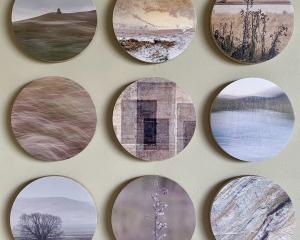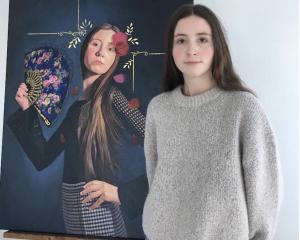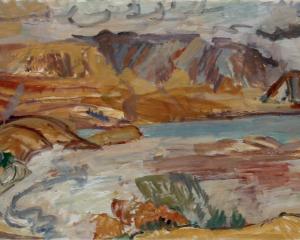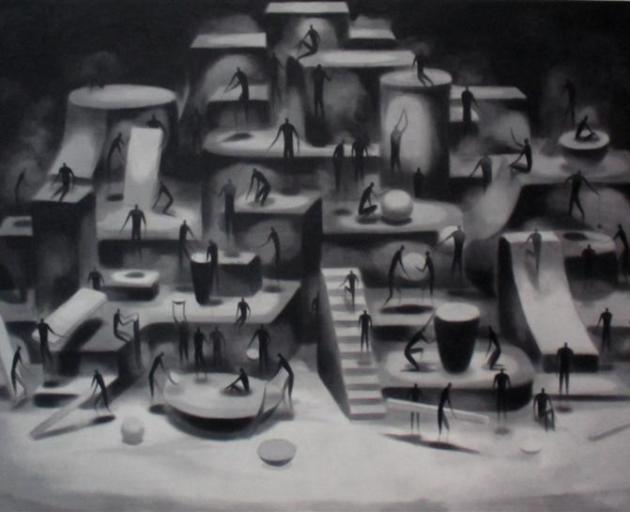
''New Works'', Thomas Elliott (Gallery Thirty Three, Wanaka)
There is something totally fascinating about Thomas Elliott's latest works.
His style has evolved over the past few years, his characteristically anonymous figures becoming more sinuous and mysterious.
Depicted in black against a lighter, smoky background, any individual features have been utterly pared down.
The human presence is represented by seemingly faceless, nameless, very busy little shadows.
Unity is a bit like looking at a still from a computer game.
The figures climb stairs and ramps, lift heavy objects, and balance on teetering heights in a stark geometric landscape that might be made of children's blocks.
All are preoccupied with their own activity, locked into perpetual labour or play, some appearing to be constructing the shapes beneath their non-existent feet, others enjoying their leisure.
At every glance, there is something new to see - a hiding figure lurking behind the stairs or disappearing off the picture plane.
In Layer, there is an almost musical sense of rhythm, as if the figures are engaged in a spiritual ritual.
Elliott paints with acrylics, but the patches of glossy finish can lend the appearance of oils.
The muted, sombre colour palette could be read as depressing or sinister, the subjects might be engaged in slave labour and misery, or it could seem magical and quirky.
The mood of the works, their subject, their underlying meaning, could all be interpreted in completely different ways, depending on the mind-set of the viewer.

Reflections: Remembering Doug Ayson (Central Stories Museum & Art Gallery, Alexandra)
Alexandra pays homage to late local artist Doug Ayson with the commemorative exhibition ''Reflections''.
Ayson was a prolific and versatile artist who remained dedicated to the production and distribution of his work throughout his life.
On display are examples of his painting, prints, drawings and illustrations, but the collection is as much a visual record of local history as it is the legacy of an individual man.
Ayson captured simple, everyday moments of past life, and elements of the Central Otago landscape that have changed considerably over the intervening decades - or, in some cases, have disappeared completely.
Much of his art was done on a highly visible, public scale.
He was a talented muralist, the best-known examples being the work he did for Terrace Distributors, painting landscapes on the sides of freight trucks to traverse the country.
Ayson combined commercial art with far more intimate, personal scenes and portraits, and the collective result offers an interesting glimpse into the facets and faces of a tightly knit community.
It also reveals hints at the actual process of art production, which usually takes place unseen and unrecorded behind the scenes of a finished piece of art.
Many of the mounted drawings and concept sketches contain Ayson's scribbled notes in the margins: instructions, suggestions and reminders to himself as he worked on the piece in question.
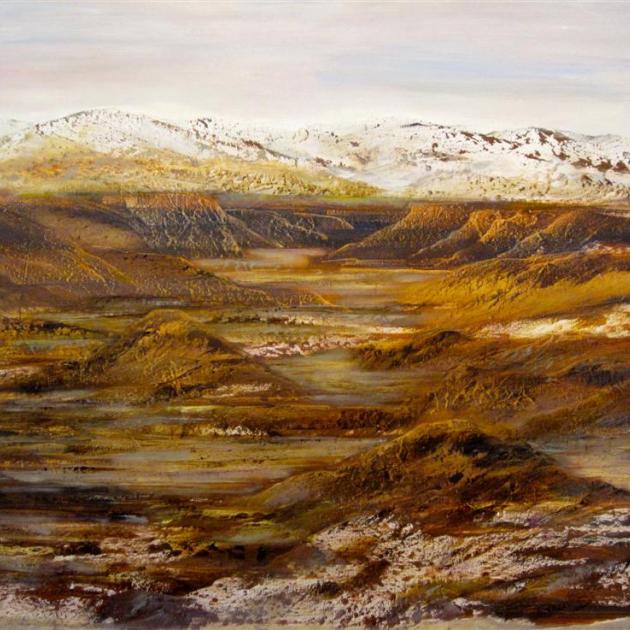
''Rolling Time and Shifting Spaces ...'', Gail de Jong (Hullabaloo Art Space, Cromwell)
Inspired by the circular narrative of Eleanor Catton's novel The Luminaries, where events don't proceed in a linear sequence and there is no definitive beginning or end, Gail de Jong explores a similar concept of infinite time and space.
Her highly textural, starkly beautiful style adapts perfectly to the subject of Otago gold-mining, the brutal realities of which have been softened by time and a surface veneer of glitz and romance.
In her Rolling Time Carrocktown, de Jong superimposes the image of a drum lid, beaten and ravaged by time, over the shape of a cross, emblazoned with the names of historic mine sites.
The allusion to a tombstone is emotive and effective.
The earthy, metallic colour palette and appearance of weathered age reflect the similar tones and textures of the larger oil landscapes.
The land is often portrayed in art and history as constant and unchanging, yet it alters every day, will never be the same from one minute to the next.
De Jong presents views of a land left scarred and eroded by an invisible human presence, yet the bleak, dusty, harsh peaks and planes, with their tinges of gold and sunlight, have a savage beauty of their own and have evolved to become something new.
Deliberate patches of white canvas are particularly noticeable in the smaller Vignette paintings, encouraging the viewer to look beyond the surface and be ''drawn into narratives of the past, by looking at the unique spaces left behind''.
-by Laura Elliott

